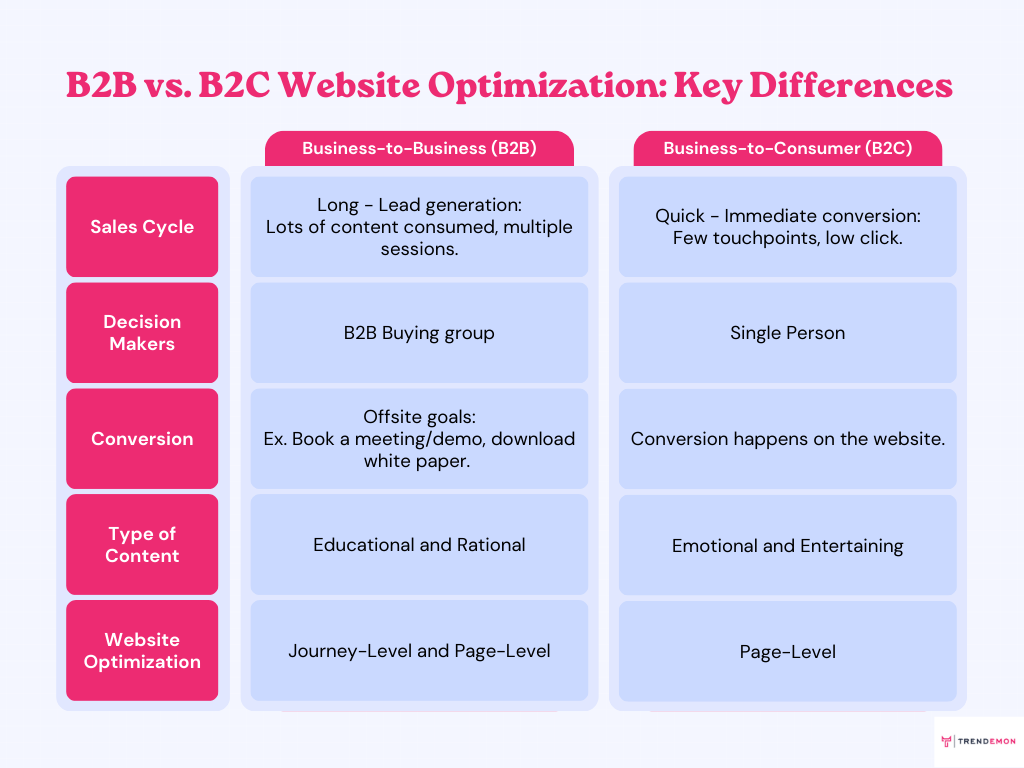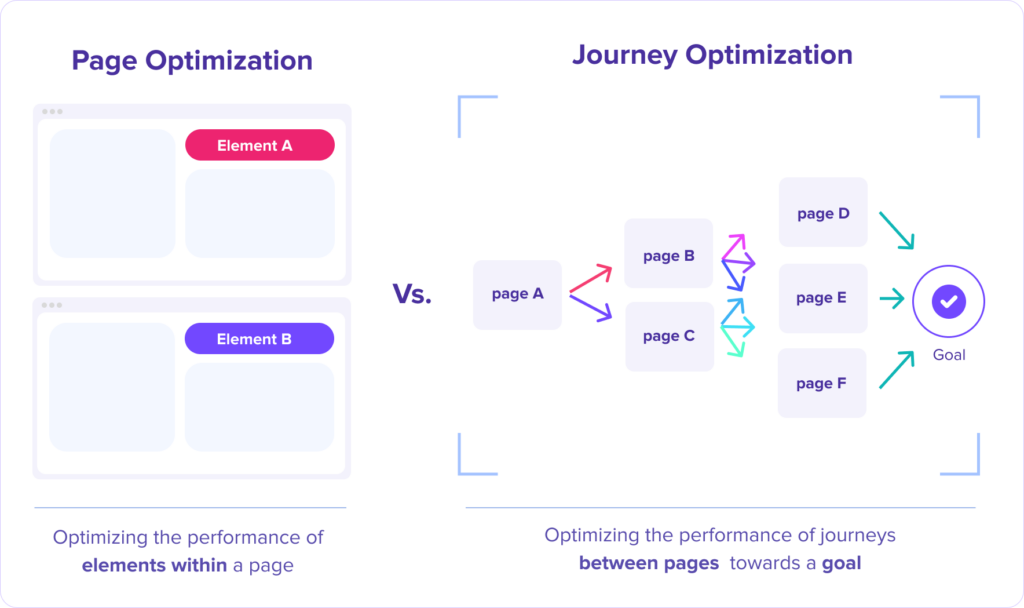Optimizing B2B Websites: Personalizing and Experimenting at Both Journey and Page Level

In the competitive landscape of B2B Marketing, strategies have become increasingly dependent on website optimization. For B2B marketers, the process of optimizing websites demands a unique approach that focuses on both the journey-level and the page-level. In this post, we will explore the world of website optimization for B2B companies, highlighting the key differences between B2B website personalization and optimization vs B2C, and why they must be a part of your strategy.
B2B vs. B2C Website Optimization: Notable Differences
Understanding the distinctions between B2B and B2C optimization is essential to develop tailored strategies for each. Here are some key differences:

The main reason why the B2C approach to website optimization does not work in the B2B landscape is that in addition to optimizing certain pages for conversion, we also need to optimize the website for specific target audiences (B2B).
What is Page-Level Optimization?
Page-level optimization centers on improving the performance of individual pages for their specific purposes. For example, optimizing landing pages to maximize conversions.
These strategies include:
1. A/B Testing/Experimentation
With A/B testing and experimentation, test different messaging, elements, and creatives on the page and learn how certain audiences interact with different page variations.
2. Page-Level Personalization
Personalizing elements on the page level, per target audience, will increase the chances of visitors engaging and connecting with the content on the page.
3. Recommendation and Engagement Units
Targeting visitors on pages with personalized recommendation and engagement units can lead to increased time spent, higher read rates, and ultimately, more conversions.
How does Trendemon support Page-Level Optimization: ACE – Audience-Based Content Elements and One-To-Won Landing Pages
Trendemon enables page-level optimization through ACE. Test messaging, images, and text links on any webpage. Personalize content for specific audiences or deliver a tailored experience for all visitors. With One-To-Won outreach, create hyper-personalized pages, that will align SDR’s outbound efforts with inbound insights and web personalization.

What is Journey-Level Optimization?
The purpose of journey-level optimization is to streamline the movement of target audiences through your website. This involves fine-tuning the entire user experience from the moment a potential client lands on the website to the point of account conversion, which usually happens off the website (in the CRM or Marketing Automation for example). Here are some key strategies that can enhance journey-level optimization:
1. Analyzing Successful Journeys Through the Website
Re-creating successful journeys is possible when you closely track entry points, buyer journey progression, content consumption patterns, engagement levels, and traffic sources. This data can then be analyzed to identify what worked and resolve any potential roadblocks.
2. Identifying Target Audiences Visiting Your Website
Modern tools can identify companies or account groups visiting a website. Let’s consider a SaaS provider for inventory management. When a retail giant’s representatives visit the website, account identification tools can flag this visit, taking note of that target audience.
3. Relevant Calls-to-Action and Recommendations Regardless Of The Page the visitor is currently on (CTAs)
Compelling and strategically placed CTAs guide target visitors toward the desired destination. Using personalized messaging, action-oriented language and highlighting the benefits of taking that action will increase the likelihood of conversions.
Journey-Level Optimization With Trendemon:
Trendemon gives you many ways to understand and optimize your visitor buying journeys:
- With Campaigns/Orchestrations Promote/recommend your best-performing assets to extended visitor journey lengths that are optimized for off-site goals.
- Our Conversion Uplift metric uncovers the impact of personalized versus non-personalized journeys as they affect your pipeline.
- ”Explore Assets” and understand which content pieces have the highest engagement/read rate.
- ”Explore Journeys” and visualize your website visitors’ experience as they move through your site.
- Use the “Navigator” to understand where your assets perform best – top of the journey, middle, or bottom.
- Create curated content experiences for prospects/audiences with Streams.
Optimizing Your B2B Website for Success
Optimizing your B2B website is a strategic endeavor that requires taking a holistic view of your audience’s journey. While page-level optimization may be enough for a B2C approach, it falls short of the lengthier, complex B2B buying journey and should be considered as part of a more comprehensive strategy. It is essential to consider a solution that incorporates both of these approaches when optimizing your B2B strategy to combat revenue leakage and missed opportunities. Embrace the journey, embrace the experience, and witness your B2B website become a conversion powerhouse.
If you want to find out more about how Trendemon can help you optimize your website at the Journey-Level and Page-Level, reach out to us here.